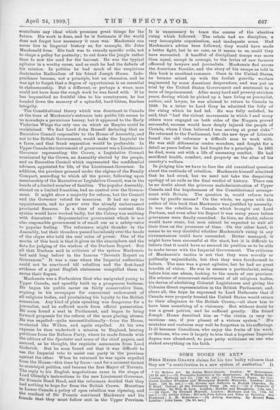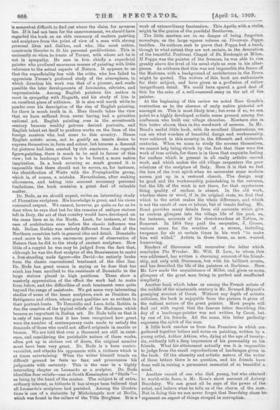SOME BOOKS ON ART.*
HEBB MEIEB-GBAEFE claims for his two bulky volumes that they are "a contribution to a new system of aesthetics." It • (1) Modern Art. By Julius Molar-Ornate. London : W. Heinemann. 1R2 2s. net..]—(2) Florentine Sculptors of the Renaissance. By Wilhelm Bode. London: Methuen and Co. [12s. 6d. net.—(S ) Vincenrio Foppa. By Con- stance Jocelyn Ffoulkes and Monsignor Itodollo Matocchi. London : John Lane. (£4 4s. net.]—(4) Screens and Galleries in English Churches. By F. Bond. Oxford : at the University Press. (13s. not.----(5) A Chronicle of Friendship. Ily Will. H. Low. London : Hodder and Stoughton. [15a. nst.I —(6) Corot. By Everard Meynell. London: Methuen and Co. floe. 6d. net.j—(7) Arthur Atkins: Nxt,acts front Letters and Notes on Painting. San Francisco: A. M. Bobertaou.—(8) Aubrey Beardsley, By Bober') Poi& London : John Lane. [3s. 6d. sot.] ie somewhat diffieult to find out where the claim for newness lies. If it had not been for the announcement, we should have regarded the book as an able summary of modern painting and sculpture from the point of view of a man with strong personal likes and dislikes, and who, like most critics, constructs theories to fit his personal predilections. This is eminently so when he treats of Turner, with whose art he is not in sympathy. He sees in him chiefly a superficial painter who produced enormous masses of painting with little reference to the actual aspects of Nature. It appears to us that the superficiality lies with the critic, who has failed to appreciate Turner's profound study of the atmosphere, in which direction his work was that of a pioneer, and made possible the later developments of luministes, in:brides, and impressionists. Among English painters the author is most in sympathy with Hogarth, and his study of him is an excellent piece of criticism. It is also well worth while to ponder over his description of the rise of English painting, for there is muoh truth in it. Herr Graefe takes the view that we have suffered from never having bad a primitive national art. English painting rose in the seventeenth century because wealthy patrons desired portraits, and gnglish talent set itself to produce works on the lines of the foreign masters, who had come to this country. Hence English artists arose, not to gratify an innate desire to express themselves in form and colour, but because a demand for pictures had been created by rich amateurs. As regards figure-painting, there is much to be said in favour of this view; but in landscape there is to be found a more native inspiration. In a book covering so much ground it is impossible that there should not be errors, as, for instance, the identification of Watts with the Preraphaelite group, which is, of course, a mistake. Nevertheless, after making allowances, and taking into account necessary personal limitations, the book contains a great deal of valuable matter.
Dr. Bode, as we should expect, writes an interesting study of Florentine sculpture. His knowledge is great, and his views command respect. We cannot, however, go quite so far as he does when he says that but for the remains of antique statues left in Italy, the art of that country would have developed on the same lines as in the North. Look, for instance, at the case of architecture even before the classic influence was felt, Italian Gothic was entirely different from that of the Northern countries both in general idea and detail. Donabello owed 1110113 to his own enormous power of observation of Nature than he did to the study of ancient sculpture. Row little of a copyist he was may be judged from the fact that, although he was the first sculptor of the Renaissance to make a, free-standing nude figure—the David—he entirely broke from the classic conventional treatment of the iliac line. Dr. Bode has great reason in saying as he does that too much has been ascribed to the assistants of Donate& in the large statues placed in high positions. These show a masterly appreciation of the effect the work had to make from below, and the difficulties of such treatment were quite beyond the range of assistants. We get some very interesting studies of some of the lesser sculptors, such as Desidero da ' Settignano and others, whose great qualities are so evident in their portrait-busts. To Donatello and Luca della Robbia is due the creation of the typical reliefs of the Madonna which . became so important in Italian art. Dr. Bode tells us that it is only of late years that it 'has been recognised how great , were the number of contemporary casts made to satisfy the demands of those who could not afford originals in marble or bronze. We are told that over a thousand are still in exist- ence,, and considering the perishable nature of these works, often put up in shrines out of doors, the original number must have been very great. Dr. Bode is a keen contro- versialist, and attacks his opponents with, a violence which is at times entertaining. When the writer himself treads on difficult ground he feels no fear, and pronounces his judgments with certainty. This is the case in a highly interesting chapter on Leonardo as a sculptor. Dr. Bode identifies four reliefs—one at South Kensington of "Strife "- as being by the hand of the master. The subject is of extra- ordinary interest, as hitherto it has always been believed that all Leonardo's sculpture had perished. Among the illustra- tions is one of a statuette by Michelangelo now at Berlin, which was found in the cellars of the Villa Borghese, It is a work of extraordinary fascination. This Apollo with a violin, might be the genius of the youthful Beethoven.
The little masters are in no danger of being forgotten, nowadays, as the large square volume on Vincenzio Foppa; testifies. Its authors seek to prove that Foppa had a hand, though to what extent they are nob certain, in the decoration. of the beautiful Poetinari Chapel of St. Eustorgio at Milan., If Foppa was the painter of the frescoes, he was able to rise. greatly above the level of his usual. style as seen in his altar- pieces. As evidence that this was not impossible the fresco of the Madonna with a background of architecture in the Breve, might be quoted. The writers of this book are enthusiasts for their subject, and have given us a profusion of rather insignificant detail. We could have spared a good deal of this for the sake of a well-reasoned essay on the art of the painter.
At the beginning of this review we noted Herr Graefe's. contention as to the absence of early native pictorial art. amongst us. This is most likely true ; but even if so, we can point to a highly developed artistic sense present among the craftsmen who built our village churches. Nowhere else is this better shown than in the woodwork of screens, In Mr. Bond's useful little book, with its excellent illustrations, we can see what wonders of beautiful design and workmanship were achieved in this country in the fifteenth and sixteenth centuries. When we come to study the screens themselves, we cannot help being struck by the fact that these were the work of true artists, for there is in them that exquisite feeling for surface which is present in all really artistic carved work, and which makes the old village, carpenters the poor relations of the sculptors of Italy. Here it is that we feel the loss of the true spirit when we encounter some modern screen put up in a restored church. The design may be good and the workmanship painstaking. in the extreme, but the life of the work is not there, for that mysterious thing quality of surface is absent. In the. old work, whether stone or wood, if in its original state, we find that which to the artist makes the whole difference, and which is not the result of care or labour, but of innate feeling. Mr. Bond provides many details from old accounts which give us curious glimpses into the village life of the past, as, for instance, accounts of the churchwardens at 'Litton, in Somerset. In 1454 they paid the carpenter, J. Crosse, various sums for the erection of a screen, including twopence for ale at certain times in his work "to make him well willed," Artists in those times, as now, wanted humouring.
Readers of Stevenson will remember the letter which concludes The Wrecker. Mr, Will. H. Low, to whom this was addressed, has written a charming account of.his friends ship, not only with Stevenson, but with his brilliant cousin,. and has described the life of the painters at Barbizon. Here Mr. Low made the acquaintance of Millet, and gives us some, glimpses of the great man living in perfect and unaffected. simplicity.
Another book which takes WI among the French artists of the middle of the nineteenth century is Mr. Everard Meynell'e gossiping account of Corot. Without any depth of artistic criticism, the book is enjoyable from the picture it gives of the radiant nature of the great painter. Most people wilt find out with regret that the famous letter describing the- day of a )andscape-painter was not written by Corot, but. by one of his friends, All the same, this letter perfectly• expresses the spirit of the man.
A little book reaches us from San Francisco in which are gathered together letters and notes on painting, written by a. young artist, Arthur Atkins, who, dying at the age of twenty- six, evidently left a deep impression of his personality on his: friends. What his attainment actually was it is impossible. to judge from the small reproductions of landscapes given in the book. Of the sincerity and artistic nature of the writer of these letters there is no question, and his friends have done well in raising a permanent memorial of so beautiful a , mind.
Another record of one who died young, but who attained to world-wide fame, is Mr. Ross's short account of Aubrey Beardsley. We can grant all he says of the power of the artist, and believe what he tells us of the charm of the man. But in doing this we can never forget that Beardsley °hose tor represent an aspect of things steeped in corruption.























































 Previous page
Previous page